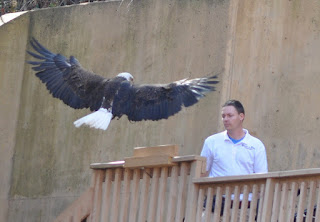Even though I didn’t discover my true passion for birds until college, I think somewhere deep down there’s been a part of me that has always loved our feathered friends.
I’ve always been interested in the happenings at the backyard birdfeeder. Seeing a red-tailed hawk outside my elementary school was wondrous at the time (and still is- my family counts them along the highway when we go on long car trips). Even today, when I work with birds of prey for a living, I still love peering out of the window to see what the local birds are up to. I’ve seen some pretty amazing birds, but a very interesting species showed up in my yard before I started college.
My brother spotted a new bird at the feeder
My brother, sister and I were looking out the back window of our living room one winter day, observing the patrons of our feeder. We had all of the usual suspects; cardinals, chickadees, titmice, house sparrows, house finches, etc. They amused us with their antics, flitting around the perches, scaring each other away. Suddenly, my brother, who was in possession of our family’s only pair of binoculars at the time, straightened up and focused in on something. “There’s a new bird at the feeder!” he said excitedly.
Naturally, this caused a squabble as we all fought to possess the binoculars, but eventually we all got a look at this newcomer. It was a small bird, with a white breast and black and brown striped wings. Its head was a rich chestnut color, and on its cheek was a black patch. While my brother kept an eye on the bird, my sister and I feverishly perused a field guide. Surely it was some kind of sparrow? It did resemble the house sparrow somewhat. Finally, on the last page of sparrows, we discovered the identity of our mystery bird. It was a Eurasian Tree Sparrow.
Happy that we had identified our black-cheeked visitor, we resumed watching the feeder after recording the new bird on the list we kept to remember what birds had come to eat with us. It wasn’t until a few weeks later, when my bird-loving aunt asked us what we had seen recently, that we realized we’d stumbled across something special. Upon telling her that we had seen Eurasian Tree Sparrows in our backyard (for now we had a solid half-dozen visiting us regularly), she promptly exclaimed, “You’ve seen WHAT!?” She then proceeded to explain to us why seeing this particular sparrow was so momentous.
....soon there were more of this Old World import
The Eurasian Tree Sparrow is actually a species of Old World sparrow, or sparrow that occurs in Europe and Asia. It is closely related to house sparrows, and not so closely related to our own American tree sparrow. In 1870, a group of 12 of these birds were imported from Germany and released in Lafayette Park in St. Louis, to increase the diversity of the local bird life. All of the Eurasian Tree Sparrows in the United States today are descended from these twelve birds. What makes them different from the house sparrow, which is an Old World species that has expanded its range to include the whole of the US, is that the Eurasian Tree Sparrow population is confined to the St. Louis area, with their range extending somewhat into western Illinois and up into southeast Iowa. This is the only place in the U.S. they occur. Many of the local birders see these birds frequently, but for anyone else in the country, they are not seen at all. People from all over the U.S. come to St. Louis to see this little sparrow, presumably because a car or plane trip to St. Louis costs somewhat less than an expedition to Europe or Asia.
My aunt demanded a picture, which we happily provided (the first of these pictures were terrible--out of focus and taken through binoculars). Eventually she was able to see them in her own yard in St. Ann, MO (my family lives in St. Charles, MO). All through the rest of the winter, and into the following summer, my family watched these little sparrows enjoy the seed at our feeders.
I see them less frequently now, but every time I do, I get a little thrill. It reminds me of that winter day, when my brother, sister, and I discovered a very special little sparrow together.
Submitted by Emily Hall, World Bird Sanctuary Naturalist



















































